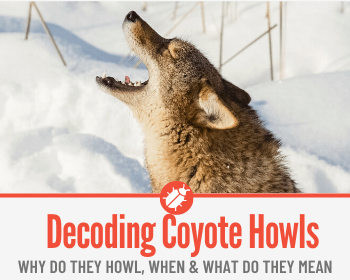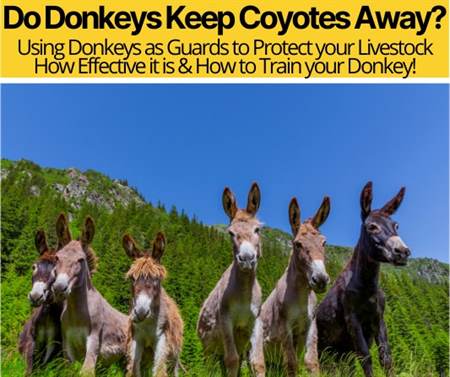 Coyotes are commonly known as the “song dogs” and are well known for their high-pitched howls.
Coyotes are commonly known as the “song dogs” and are well known for their high-pitched howls.
Much like other animals, coyotes are very vocal. But the coyote stands out as an animal with a distinct howl and pitch.
So why are the high-pitched and almost-haunting howls of the coyote so distinct? Why do they howl and what do the coyote howls mean?
Why do Coyotes Howl?
Many animals communicate with each other verbally, and the coyote is no different. Coyotes howl mainly for two reasons: to communicate with the other members of their pack and to establish territory.
It is interesting to note that coyotes will not howl to attract their pups. Instead, they most often use gruff barks to warn their pups to retreat to the den and to beware of danger in the area. Howling would only draw attention a predator’s attention to the pups.
To Communicate with the pack
When traveling, hunting for food, or roaming their territory (or home range), coyotes will often howl to communicate with each other.
There are two main times when coyotes will howl to communicate with the pack.
- When hunting
After a coyote has been hunting alone, it will often howl to call out to its pack. The pack will reply with howls of their own, allowing the lone coyote to find his way back to the pack.
- When signalling
If a coyote notices another pack nearby, it will howl to warn its own pack of the possible invaders.
To establish territory
The coyotes’ howl is also a warning to nearby packs.
- When maintaining borders
Often, a coyote will travel his home range and maintain his borders. He will mark his borders with urine or by leaving scat, which is rope-like coyote feces that is filled with hair and bones.
After he has re-established his scent on his territory boundaries, he will often howl. This howl serves as a sort of auditory boundary reinforcement.
- When warning other coyotes
When the coyote senses a coyote not in his pack, he will often howl. This howl warns the other coyote that he is approaching another pack’s boundaries and not to invade the territory.
What does a Coyote Howl Sound like
There are three identifying features to the coyote’s howl.
- The first is that his howl is short and high-pitched.
- Most notably, the coyote’s howl rapidly rises and falls in pitch and even wobbles at times.
- The third identifying feature of the coyote’s howl is that it is frequently interrupted by a chorus of small yips and barks.
Listen to these audio tracks to hear what a Coyote Sounds like When Howling
Group of Coyotes Howling:
Audio Player
Single Coyote Howling:
Audio Player
A Pack of Coyotes Howling and Yipping:
Audio Player
The coyote’s howl is often known to sound like a woman screaming.
Baby coyotes, or pups, can also howl. At a couple of weeks old, the pup can lift his head back and give a tiny, high-pitched howl.
A coyote’s howl is different from every other animal in pitch and tone.
The wolf’s howl is different in that it has a long, drawn-out howl with a slow, smooth tone that gradually rises. Often, it sounds like “Owooo.”
The fox’s howl is short, high-pitched scream rather than a howl. Often, the fox’s howl sounds like a person screaming “Bloody murder!”
A dog’s howl is lower pitched with a definite adjustment in the middle of it. Often, it sounds like someone saying “Oww-uwww.”
When Do Coyotes Howl?
During mating season
The early months in the year, from January to March, are the coyotes’ mating season. During this season, coyote howling will be quite prevalent as lonely males look for their mate.
During this time, the female coyote will often invitation howl to let other males know she is available. The female’s howl is higher-pitched and cleaner than the males. Often, she will also alternate between howling and whimpering. Her whimper is a submissive sound similar to the whimper of a concerned or needy dog.
When pups leave
From September to November, you will hear more howling (especially group yip-howling). This. Is because the pups born in the spring are now old enough to leave the pack.
The pups and the pack will still communicate as the pups branch out to find their own place, either in the pack’s territory or outside the territory.
When hunting
While coyotes live in packs, they usually hunt solo, in pairs, or in small groups (especially if they are a family). And, they can separate for 4 to 10 kilometers. Whenever they spread out or reunite, they will howl as a group to show strength in numbers, but they will also howl to find each other.
Do coyotes Howl when they Catch Prey?
When they hear coyotes howling, many people assume that the coyotes are howling because they just made a kill.
But that is not the case.
Coyotes will howl for many different reasons, but not usually when they’ve just caught their prey. Howling would draw the unwanted attention of other nearby predators who would steal the coyote’s kill.
Rather than howl, they are most likely to bark or growl to protect their kill from curious predators.
When do coyotes howl the most?
Coyotes are nocturnal animals, which means they are most active during the night or twilight hours than any other time of the day. This means they howl the most from dusk until dawn and in the winter when the night comes sooner.
Why do Coyotes Howl at Night?
Coyotes howl at night because that is when they are the most active.
Most often, coyotes are out hunting for food at night and are either howling to intimidate other predators or to find each other to re-group.
Howling at the moon
Despite popular belief, coyotes do not actually howl at the moon. But, the moonlight can create conditions that cause coyotes to communicate more, causing more howling.
Defending territory
The additional light from the moon allows coyotes to see their borders better.
If a defending pack is ranging the territory during the moonlight and sees another coyote or pack, they will howl to audibly defend their borders.
Hunting together
With the extra light from the moon, coyotes can see further for hunting. When hunting as a pack, coyotes will howl to intimidate their prey, communicate location with the other members, and communicate where the kill is.
Distracting predators
Not only are the coyotes able to see further in moonlight, but also their predators. When a coyote pack contains pups, their scent and small yelps can attract predators.
Often, coyotes will separate, running in different directions away from the den and the pups, all while howling. This technique is meant to confuse the predator and lure them away from the den and the pups and toward the howling.
Howling during the day
Even though they are naturally nocturnal animals, coyotes have been known to howl during the day.
This is because the coyotes who live near humans have become used to the sounds and disturbances during the day, leading them to investigate and hunt.
What Does it Mean when Coyotes Howl?
Coyotes have several different types of howls that have distinct meanings.
- Single/Lone Howl
The purpose of this howl is to give out a coyote’s location to his companion.
When hunting, coyotes will often leave the pack in pairs and then separate from their companion by a few kilometers.
This single or lone howl is how the hunting pair finds each other to reunite.
The howl usually starts with a few barks that are then followed by a single howl. Soon, the other coyote will howl in response, giving off his distance and location for the first coyote to find him.
- Group Howl
The purpose of this howl is to announce that the pair has reunited and to signal the others.
After the pair has reunited, both coyotes will howl, telling the pack that they have reunited and instructing others to come find them.
This howl can also be used as an answer to a lone howl for a single coyote to come and join the group.
- Yip-Howl
The purpose of this howl is strengthen the pack’s bonds and intimidate intruders.
If you’ve ever heard a coyote howl, you’ve just probably heard a group yip-howl. A pack normally yip-howls when they are reunited after a hunting session or before they split to go hunting.
The yip-howl is a combination of sounds, that at a distance, sound like crying, screaming, and laughing at the same time. The pack uses this yip-howl as a symbol of strength and union within the pack.
How coyotes yip-howl
The group’s alpha male begins the group yip-howl with a long, high-pitched howl. The alpha female then joins in with her short, high-pitched yips, barks, and small howls.
Then, beta coyotes or older children in the pack insert their own yips and barks. Finally, the pups join in.
The result is a cacophony of long howls accented with short, high-pitched yips from the area all around.
Because it sounds like the yips are coming from many different locations, the group yip-howl can give the impression of a large pack of coyotes.
But, this is often not the case.
Instead, coyotes fluctuate the pitch of their yips and barks, creating an audible illusion called the beau geste effect. This effect is what gives the impression that there are more coyotes in an are than there actually are.
Continue reading: Why Do Coyotes Yip
Related Questions
Why Do Coyotes howl when They Hear Sirens?
Siren wails will often cause a vigorous session of coyote howling.
While scientists are not entirely sure why coyotes howl at sirens, recent theories are that coyotes respond to the siren because it sounds like an alpha’s howl, because they are warning fellow coyotes, or because the sound hurts their ears.
Can Imitating a Howl Attract coyotes?
Yes, imitating a howl can actually attract a coyote. Hunters will often use a call, or a device that imitates the sounds of a certain animal, to attract coyotes to their location.
Most often, hunters use sounds of a mating female, a lone coyote, or a pup’s whine to attract coyotes.
This means, however, that you should not try to intimidate a coyote by imitating their howl.
Should I be concerned if I hear Coyotes Howling Nearby?
Coyotes do not represent an actual threat for humans, but since they are quite adaptable and instinctive creatures, they will not flee right away. They are very territorial, but they will only attack if they feel threatened (especially if they have a fresh kill or pups to protect).
Just always remember that because they are wild animals, and their behavior is almost always unpredictable, it is better to leave them alone and avoid contact.
Often, the coyotes are not as close as they sound. Human ears can hear a coyote howl that is 3 to 5 miles away.
If you hear coyotes howling nearby, there is not usually anything to worry about. Unless the coyotes are acting aggressively towards you or your pets, just relax and listen to the coyote’s song.






